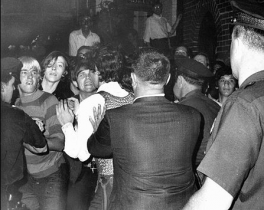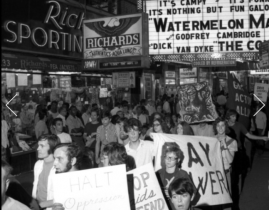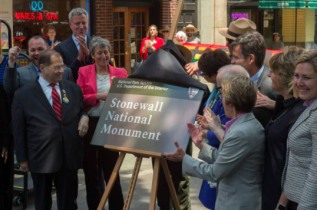The Upbringing and Influence of Stonewall Inn
Stonewall Inn today is recognized to be the iconic destination in by its nightlife, community, and history in the Greenwich Village neighborhood. It gathers the LGBT community in New York City and even internationally during the famous New York City Pride Parade, serving as the endpoint of the march. However, before the glorious and entertaining bar that it is seen today, Stonewall has been through a path of violence and discrimination in order to gain the acceptance it deserved. One of the most famous incidents know as the Stonewall Riot, illustrates the turning point of social discrimination against the gay, lesbian, and trans community that found comfort in this small ball in the Village.

At the time prior to the 1969 Stonewall Uprising, the bar was owned and operated by the Mafia in the city. Many gay bars actually, were owned by and ran by the Mafia in a mutually beneficial relationship. With such a strong presence of power in New York, the Mafia saw a business opportunities in the gay population as majority of that population are usually financially well off.[1] Although homosexuality was legal in the state of New York, establishments that served to gay customers were considered to be “disorderly houses” or place where “unlawful practices are habitually carried on by the public” by the State Liquor Authority (SLA), so they often refused to issue them liquor licenses. Those businesses that already had licenses would often be raided by the police and be shut down for “indecent conduct.” With the power of the Mafia, specifically Ton “Fat Tony” Lauria, who purchased and ran the bar, Stonewall was able to stay open for business as he bribed the police to turn a blind eye to the establishment. At the same time, the bar brought a lot of business for “Fat Tony”, created the mutually beneficial relationship.[2]
Stonewall registered as a “private club”, which was not unusual for gay bars because they didn’t require a liquor license and not as easily entered by the police. But also due to the lack of law and order, Fat Tony also cut corners of a few regulations that harmed the patrons. Bartenders didn’t have access to running water and drinks would be served in used glasses to cut costs; many blamed them as one of the primary reason for the outbreak of hepatitis because of the poor hygienes that the bar had. Those who reported to have hepatitis were often costumers of Stonewall. They also lacked a rear exit in case of emergency so the only way in and out of the bar was the narrow entrance at the front. The liquor that was provided was often watered down and was sometimes bootlegged as well. Although the conditions were rough and the quality was subpar, it still attracted business because it was a place of comfort and a place where you can be yourself. Visitors would be greeted by a bouncer, who inspected them prior to entry to make sure they weren’t under cover cops or under aged. The entry fee is $3 for two tickets that can get them two drinks. They were also required to sign their name in a book to prove that Stonewall was a private “bottle club”, but majority gave a fake name.[3] The inside of the bar was painted black with black lights and if police were spotted, they would put on white light as a signal so people can stop dancing and touching. If police did show up to raid, those without ID, in drag, and majority of the employees of the bar would usually get arrested. The customers knew about the consequences that they can face if and when they get caught during the raids, which were common for gay bars across the neighborhood.[4]
On June 29, 1969, an unexpected raid brought Stonewall to one of the most iconic and historic riots in history. Undercover officers went in the bar earlier to find evidence in order for the raid to occur and two patrol officers then came to pound on the double doors of Stonewall demanding to “take the place.” A traditional raid, however, would be to have everyone lined up, checked their identification, and sort out which they can release and which they are taking to the station. But in this particular raid, those who are released stood by the door to watch rather than leaving the place right away, thus created a crowd of 100 to 150 people along with bystanders who were curious and watched. When the patrol wagon arrived to take the people to the police station, many in the crowd would shout good-humored reactions like “Gay power!” or start singing.[5] An officer then shoved a transvestite’s head into the hood of a car and she responded by hitting him on the head with her purse. Meanwhile, a woman in handcuffs was being beat in the head by an officer with a baton, which was the turning point that began the riot. She yelled at the crowd “What don’t you guys do something?” after the officer shoved her into the back of a wagon. The crowd then went crazy and the police tried to restrain them, knocked a few people down, which infuriated the crowd even more. They started slashing the tires off of the police cars and tried turning some over. The commotion created more attention and some began to throw spare change at cops because the only reason Stonewall was getting raided was because they didn’t pay off the cops. At this point, the crowd drew more than 400 people, outnumbering the amount of officers by a landslide.[6] This then led to a mob, where the crowd was throwing anything they can find, leading to broken windows and soon escalating to lighting garbage on fire and throwing it through the windows into the bar. Fire trucks, the Tactical Patrol Force, and the NYPD soon arrived to assist the low amount of officers and to calm and break up the crowd.[7] They created a formation in attempt to push the crowd back and to clear the streets. The crowd fought backs, resisting the formation and began cheering as a community in their own formation, linking their arms together against a row of helmeted policemen stretching across the width of the street.[8] They’ve came to realize that they are no longer just a small group grabbing drinks on half off Tuesdays, there are more in the gay community than they think. One middle-aged lady with her husband told a cop that he should be ashamed of himself. “Don’t you know that these people have no place to go and need a place like that bar?” she shouted.[9] They never knew how much supporters they had until they were all together in one place. They fought because they had the manpower and people to do so, to fight for their rights. Still, officers were smashing people’s heads with a baton and pushing and shoving the human wall created by the angry mob.

Three hours after the protest, the streets were cleared but people were still around near Christopher Park. The aftermath of the riot included thirteen arrests, some in the crowd were hospitalized and officers were also injured. Stonewall Inn itself was pretty much destroyed and the streets was a disaster as well. Many came to Stonewall the next day and graffitied the bar with gay positive sayings after the riot circulated the news outlets. At night, another riot began with some of the same participants from the night before along with some curious bystanders and police provocateurs.[10] On this night, homosexual affection were displayed in public as a sign of rebellion to gain acceptance and express their true selves instead of doing that inside the walls of the bar. Stonewall opened again and thousands gather outside, surrounding Christopher Street and nearby in the neighborhood and continue to have demonstrators for the next few days. However, not everyone in the gay community thought this behavior was valid; in fact, some were embarrassed and don’t want the gay stereotype to be more negative than it already is. Protestors climbed up lampposts and dropped a heavy bag onto the hood of a police car and shattered the windshield. More than a hundred officers were present to capture the demonstrators, but the crowd would surge and recapture them and the battle continued until roughly 4:00am.
Six months after the riots, a newspaper was created by gay activities called Gay, the first publication with the word “gay” in the title. The number of readers was estimated to be around 25,000, which was higher than projected.[11] The Gay Activist Alliance (GAA) was formed and they focused on gay issues and expressed their dignity and value as human beings. They focused on liberalizing the gay community through public relations opportunities, starting with politicians. The mayor of the city at the time, John Lindsay, was often forced by the GAA to acknowledge gay and lesbian rights. The riot influenced the community to realize that there are more of them than they think, and that if they stand together, they can gain accept from society. Homosexuality was still recognized as a mental illness at the time until 1973 when the American Psychiatric Association voted to remove it off the list, and the GAA played an enormous role to get that revoked.[12]

A year after the riot marks the Christopher Street Liberation Day on June 28. This was considered the first gay pride marches in history simultaneously to the marches in Chicago and Los Angeles. The march in New York covered 51 blocks from Christopher Street to Central Park which participants marching with banners and signs. Many supported the march or were indifferent about the activism. New Yorkers especially seemed to favor the LGBT more than neglect. However, those who disliked the gays would often called them “sick and perverted” and provoked the movement.[13] Regardless of the social status of how the public portrayed the community, this was a pivotal change that was brought by the Stonewall Riots that led to many other cities to participate in marches.
Two years after the riots, there were gay rights groups in every major American city, Canada, Australia, and Western Europe.[14] The bar stood for a literal example of gays and lesbians fighting back. Stonewall went from a Mafia owned bar to the icon and center of the liberalization of the LGBT community. In 1999, the US Department of the Interior designated 51 and 53 Christopher Street and the surrounding streets a National Historic Landmark, the first to the LGBT community. The Assistant Secretary of the Department, John Berry, sourced Stonewall to be the spot where “men and women stood proud, stood fast, so that we may be who we are, we may work where we will, and live where we choose and love whom our hearts desire.” The Stonewall Inn itself was named a National Historic Landmark in 2000 and Greenwich Village Historic District as a preserved area.[15]
Stonewall was compared to with Seneca Falls and Selma by President Obama in his 2013 inaugural address on its important to the gay community. It was the first time that a president mentioned gay rights in an inaugural address and he contributed a lot to the community as well. In 2015, New York City unanimously approved the designation of the Stonewall Inn as a city landmark, the first honoring for its role in the fight for gay rights. The following year, President Obama announced that the establishment as well as Christopher Park as a National Monument, administered by the National Park Service.

The monument consists of 7.7 acres including the adjacent areas of Stonewall and Christopher Park and Stonewall is still privately owned.[16] Again, from Mafia bar to a national monument, Stonewall represents the history and icon of gay rights, equality, and a place of comfort for those who were neglected by societal norms by the role of their sexuality.
Bibliography
[1] Stonewall Uprising. Directed by Kate Davis and David Heilbroner. USA: First Run Features, 2010.
[2] Duberman, Martin B. Stonewall. New York, NY, U.S.A.: Dutton, 1993.
[3] Duberman, Stonewall, 183.
[4] Duberman, Stonewall. 189.
[5] Roberts, Steven V. “Homosexuals in Revolt.” The New York Times, August 24, 1970, Col.8.
[6] “Police Again Rout ‘Village’ Youths.” The New York Times, June 30, 1969.
[7] Carter, David. Stonewall: The Riots That Sparked the Gay Revolution. New York: St. Martin’s Press, 2004.
[8] “Police Again Rout ‘Village’ Youths.” The New York Times, June 30, 1969.
[9] Leitsch, Dick. “Police Raid on N.Y. Club Sets off First Gay Riot.” The Advocate, September 1969.
[10] Carter, Stonewall: The Riots That Sparked the Gay Revolution, 180.
[11] Duberman, Stonewall. 189-235.
[12] Carter, Stonewall: The Riots That Sparked the Gay Revolution, 245-246.
[13] Duberman, Stonewall, 278-279.
[14] Adam, Barry D. The Rise of a Gay and Lesbian Movement. Boston: Twayne Publishers, 1987.
[15] Dunlap, David. “Stonewall, Gay Bar That Made History, Is Made a Landmark”. The New York Times, June 26, 1999.
[16] “Lesbian, Gay, Bisexual, and Transgender Pride Month, 2009”. The White House, June 1, 2009.
[17] Carter, Stonewall: The Riots That Sparked the Gay Revolution, 183.